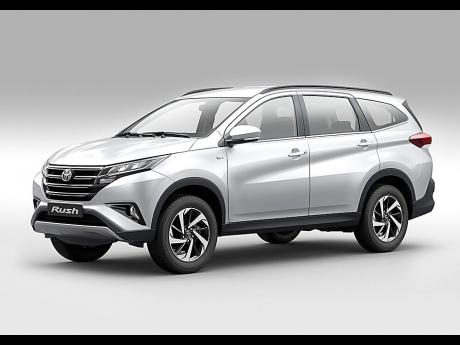Toyota feeding the SUV rush
You'd be forgiven if you walk up to the side of the 2019 Toyota Rush and think it is the latest Rav4. They both have the same ride height and the side-on lines are strikingly similar, but all that ends when you step back and look at the length. It is then that you get the feeling that you are looking at a baby Fortuner and it is a feeling that you can't shake when you look at the back and even the front with the generous grille that definitely takes styling cues from the Fortuner.
Probably one way of settling the tail-spin of similarities is to adapt a crude description among gearheads that the rear-wheel drive vehicle looks like a mating between the Fortuner and RAV4 to produce the Toyota Rush.
The 1.5-litre SUV comes standard with six airbags, alloy rims, and push-button start. All indications are that it is aimed at the 'efficient' people mover segment of the market. Up until 10 or so years ago, that job was the province of the station wagon or the mid-sized sedan. But with the automotive gods ordaining that ride height, seating capacity and functionality are important, then an SUV, or at worst a Crossover vehicle, offers the route to salvation.
To be clear, the Toyota Rush has been around for some time. In a previous life it came to Jamaica as the Daihatsu Terios back in 1998. At that time it came with a small but willing 1.3 litre power plant mated to a 5-speed manual gear box. By about 2005, the shape changed to make the Terios look like the Rav4's little twin with a 1.5 litre engine doing duty with a 4-speed automatic tranny.
All along in the Jamaican market it was called Terios while in the Japanese and some other markets it was called the Rush. Clearly Toyota, is sensing that Jamaica is like the rest of the world, feeling an SUV or Crossover rush is feeding it with the formal introduction of the Toyota Rush.
Our test model was the econo-spec version but we weren't missing much. Open the doors with standard keyless entry and the interior design looks upmarket, with contrasting colours and stitching. Don't scoff at the plastic interior as this is important for a vehicle expected to put up with the use and abuse from its cargo, human or otherwise.
The positives: it's easy to clean. Those in the front will enjoy the soft, comfortable seats. From the driver's position, all the major controls are clear, easy to read, operate and reach. There is a nice, high, generous right height that allows the driver to sit proud above the chaos reigning on the typical Jamaican road. To be sure you will see everything in your line of view early enough to take action. Many will love the view out the windshield due to higher-than-normal seating position created by a combination of the seat itself, the Rush's steeply angled nose and tall ride height. Visibility is good due to the size and number of windows the Toyota carries.
To many, a third row may sound like a gimmick, but this plays well with the intended target market - families. Pull a lever and either side of the second row easily flips forward for access. The two third-row rear seats are best accessed from the trunk area. With a 2-3-2 seating layout, most will relegate children to the third row during full-load trips. The back seats folds forward so that you can get more room for storage and it goes all the way to the front seats so that the Rush can become an efficient cargo carrier.
The dash board lights up nicely with all of the gizmos you would expect in a modern SUV. The 1.5L 2NR-VE inline four is a variant of the 1NR found in some Corollas. It comes with the Dual VVTi (Dual Variable Valve Timing intelligent) specifications; in other words, don't go stomping on the gas expecting a thoroughbred to lunge forward, but rather a gradual, smooth delivery of power that will be sure to get you there. The engine revs readily to about 4000 RPM and then the VVTi takes over producing a yes-I-can note that tells you that the Rush will take you places.
Pull out to the open road and the suspension suffers initially from a little too much body roll but get past that and what you get is a firm assured thud that soaks up those nasty Jamaican potholes, thus giving a smooth comfortable ride. Our test model was with us for the better part of a full day and gave rise to many positive enquiries from those who saw it in The Gleaner parking lot.
Among the eager questions was about the price. Expect to pay just over $4.6 million for the Mid-Spec version we tested or pay just about $250,000 more for the High Spec version. Those with a 20 per cent duty concession can expect to get a bargain at $3.7 million for Mid-Spec and $3.9 million for the High-Spec version. With its starting price point, the SUV will be in direct competition with the Suzuki Vitara, Hyundai Creta, and Mitsubishi ASX but with its ability to seat seven people the Rush will win hands down … definitely value for money.




